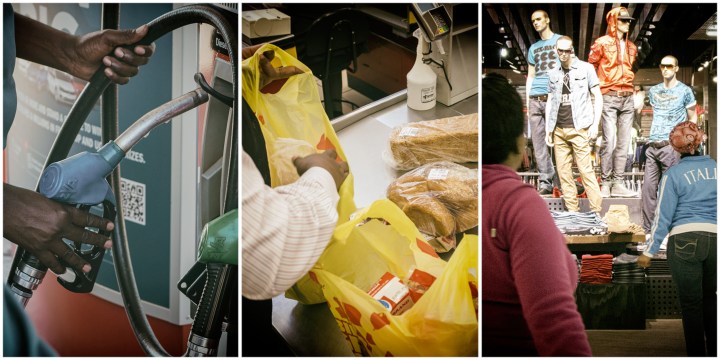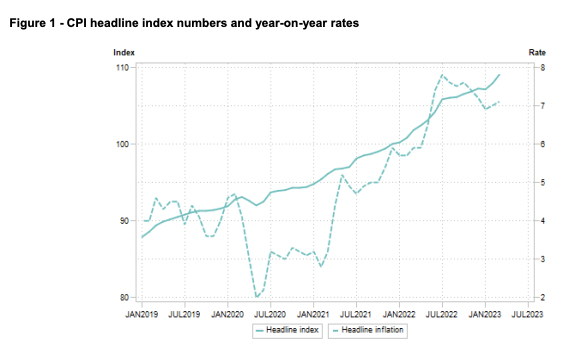RECESSION GLOOM
Cost-of-living crisis – SA CPI accelerates to 7.1% in March, food inflation at 14-year high

South Africa’s cost-of-living crisis is worsening as winter looms, with consumer inflation still accelerating and food inflation hitting a 14-year high in March of 14.4%. Adding to the gloom, retail trade sales fell 0.5% year-on-year in February, the latest sign that South Africa’s economy has fallen into a recession.
South Africa’s consumer price index (CPI) sped up to 7.1% in March from 7.0% in February, raising the possibility of further interest rate hikes despite the evaporating prospects for economic growth.
The data, released on Wednesday by Stats SA, also highlight the worsening scale of South Africa’s cost-of-living crisis. Food inflation accelerated to 14.4% in March from 14.0% in February. That is its highest level since March 2009 when it reached 14.7% in the wake of the global financial crisis.
Prices for bread and cereals rose 20.3% in the year to March, a trend that is inflicting huge hardship on poor and working-class households who rely heavily on maize meal as a caloric staple. Stats SA recently reported that in 2021, about 2.1 million South African households, or 11.6% of the total, reported experiencing hunger.
One suspects that hunger has risen since with food prices or, at the very least, has hardly abated. The proverbial breadwinner in South Africa needs to win a lot more to put the same amount of bread on the table. And South Africa continues to buck a global trend on this front, with the power shortages playing a key role.
“While global food prices have continued to fall, 2.1% month-on-month and 20.5% year-on-year in March, local food inflation appears to be exacerbated by idiosyncratic factors – mostly related to energy supply constraints,” Koketso Mano, FNB senior economist, said in a note on the data.

Still, analysts see some rays of hope emerging on the horizon.
“We expect consumer food price increases to remain sticky at relatively higher levels for the coming month, which will likely be a peak. There could be some moderation from around May and into the year’s second half,” said Wandile Sihlobo, chief economist at the Agricultural Business Chamber (Agbiz).
“The impact of load shedding may also influence prices for the next few months. The mitigating measures businesses are currently making to improve power supplies, along with the diesel rebate announced by the finance minister, should bear fruits later in the year. Positively, global agricultural commodity prices are softening. If the rand/dollar exchange rate remains relatively strong, this will soon be a reality in South Africa, with a lag at the retail level.”
South Africa’s summer grain and oilseeds crop is seen amounting to 19.6 million tonnes this year, 5% higher than last year, and that should also help to cool food prices which have a lag of between three and five months between the farm and the retail shelves. Agbiz sees food inflation in South Africa easing to 7% to 8% in 2023, which is still a high level, especially for poor households.
Reserve Bank vindication
The quickening pace of inflation meanwhile will be seen as vindication by the South African Reserve Bank (Sarb) for its 50-basis point hike last month, which flew in the face of expectations that it would only impose one of 25 basis points. Most economists expect that the Sarb is at or near the peak of its tightening cycle. Since late 2021, it has hiked rates by a cumulative 4.25 basis points, bringing its repo rate to 7.75% and the prime lending rate for consumers to 11.25%.
But the Sarb could still keep pulling the trigger as the CPI remains well outside its 3% to 6% target range. Governor Lesetja Kganyago warned economists at the last Monetary Policy Committee meeting in March not to underestimate the Sarb’s resolve in tackling inflation.
“They actually believe that the central bank is not serious about tackling inflation. But we are serious about tackling inflation,” he said.
Read more in Daily Maverick: SA Reserve Bank hikes repo rate by 50 basis points after inflation, rand set alarm bells ringing
Inflation, combined with the rising rates and a moribund economy that contracted 1.3% in the last quarter of 2022 and remains under the relentless onslaught of rolling blackouts, is clearly straining the South African consumer.
Stats SA also said on Wednesday that retail trade sales fell 0.5% year-on-year in February and by 0.1% on a monthly basis compared to January. It all adds up to a 0.6% decrease in the three months to the end of February compared with the same period last year and is further evidence that the South African economy is likely to have contracted in the first quarter of 2023, meaning that it has fallen into a recession.
And a recession that coincides with rising inflation in turn signals that South Africa’s economy remains trapped in the steel-like jaws of stagflation. It is a trap from which there is no easy way out. DM/BM

















 Become an Insider
Become an Insider
Comments - Please login in order to comment.